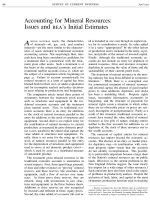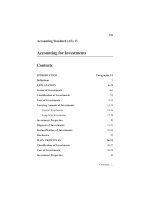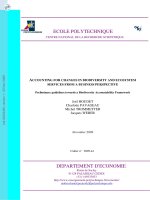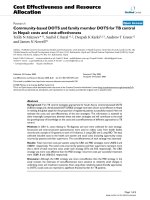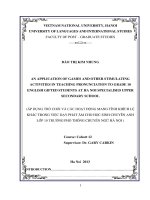13 accounting for calculating manufacturing costs and product prices at ha noi civil electric hydraulic and industrial consultant jsc
Bạn đang xem bản rút gọn của tài liệu. Xem và tải ngay bản đầy đủ của tài liệu tại đây (656.63 KB, 78 trang )
MINISTRY OF FINANCE
ACADEMY OF FINANCE
--------------------
Student:
Đào Thị Hoa
Group:
CQ55/ 51.04
GRADUATION THESIS
TOPIC:
Accounting For Calculating Manufacturing Costs And Product Prices At Ha Noi Civil
Electric Hydraulic And Industrial Consultant Jsc
Major
: English for accounting and finance
Student code
: 17522202010109
Supervisor
: Dr. Trần Thu Hoài
Hanoi – 2021
DECLARATION
I hereby undertake that this internship report was written by myself based on the
actual results that I researched and collected during the actual internship at the
company.
Thesis: “Accounting of evaluating manufacturing cost and product price at
Ha Noi Civil Electric Hydraulic and Industrial Consultant JSC”
Hanoi, May 20th 2021
Student
Đào Thị Hoa
ABSTRACT
This study researched the accounting of evaluating manufacturing cost and
product price in Ha Noi Civil Electric Hydraulic and Industrial Consultant JSC. The
paper aims at finding out the achievements and drawbacks in accounting activities in
Ha Noi Civil Electric Hydraulic and Industrial Consultant JSC, especially the areas of
cost accounting and then suggesting main methods to improve the efficiency of
accountant in the company. This graduation thesis present the process of accounting
activities based the experience directly in the company point out whether it is effective
or not. From received results, the study argues that student need to Students need to
provide optimal solutions to solve arising problems, inadequacies in the company's
accounting operations, and improve the company's business in the future.
ACKNOWLEDGEMENT
I would like to express my deep gratitude to all those who have given me the
possibility to complete this graduation thesis. In preparing this graduation thesis, I have
had generous help and advice from my teachers, my colleagues, my family and my
friends. I would like to express my great thanks to all of them.
First of all, I would like to express my deepest gratitude to my supervisor, D.r.
Tran Thu Hoai, lecturer of Academy of Finance, for her guidance and instructions. It is
whole-heartedly appreciated that your great advice for my study proved monumental
towards the success of this study.
Second, I wish to show my sincere thanks to all my teachers at Academy of
Finance, who have provided me with worthy lessons throughout 4 years of study.
Moreover, I am indebted to the staffs of Ha Noi Civil Electric Hydraulic and
Industrial Consultant JSC for their valuable supports during the internship. I am
extremely thankful and indebted to them for sharing expertise, and sincere and valuable
guidance and encouragement extended to me.
Furthermore, I would like to send my loving thanks to my family whose great
love and care in both spirit and health to encourage me to complete the thesis.
Last but not least, I also place on record, my sense of gratitude to one and all,
who directly or indirectly, have lent their hand in this thesis.
LIST OF ABBREVIATIONS
1. Ac: Account
2. Cr: Credit
3. Dr: Debit
4. JSC: Joint-Stock Company
5. VND: Vietnam Dong
6. VAT: Value-add tax
LIST OF FLOWCHARTS AND TABLES
List of flowcharts
Flowchart 1.1. Accounting entry for direct material costs---------------------------------24
Flowchart 1.2. Accounting entry for direct labor cost--------------------------------------25
Fowchart 1.3. Accounting entry for factory of overhead costs----------------------------26
Flowchart 2.1: Board of Ha Noi Civil Electric Hydraulic and Industrial Consultant JSC
---------------------------------------------------------------------------------------------------- 34
Flowchart 2.2 Accounting apparatus---------------------------------------------------------36
Flowchart 2.3. Accounting process at the company----------------------------------------39
List of tables
Table 2.1. The main fields of activity of the company-------------------------------------33
Table 2.2. The Company’s business result from 2018-2020-------------------------------38
Table 2.3. Insurrance rate apply following to insurrance law-----------------------------43
TABLE OF CONTENTS
DECLARATION--------------------------------------------------------------------------------- 3
ABSTRACT-------------------------------------------------------------------------------------- 4
ACKNOWLEDGEMENT---------------------------------------------------------------------- 5
LIST OF ABBREVIATIONS-------------------------------------------------------------------6
LIST OF FLOWCHARTS AND TABLES----------------------------------------------------7
INTRODUCTION------------------------------------------------------------------------------ 12
1. RATIONAL OF THE STUDY-------------------------------------------------------------12
2. AIM OF THE STUDY----------------------------------------------------------------------13
3. SCOPE OF THE STUDY------------------------------------------------------------------13
4. METHODOLOGY-------------------------------------------------------------------------- 13
5. ORGANIZATION OF THE STUDY-----------------------------------------------------14
CHAPTER 1: BASIC THEORIES ABOUT THE ACCOUNTING OF
MANUFACTURING COSTS AND PRODUCT PRICING IN COMPANY.-----------15
1.1. Overview of accounting------------------------------------------------------------------15
1.1.1. Definition of accounting---------------------------------------------------------------- 15
1.1.2. Functions and responsibilites of accounting-----------------------------------------15
1.1.3. Characteristics of accounting----------------------------------------------------------16
1.2. Accounting for calculating manufacturing costs and product prices at a
manufacturing enterprise.---------------------------------------------------------------------- 17
1.2.1. Content of manufacturing cost---------------------------------------------------------17
1.2.2. Accounting subjects for calculating maufacturing costs and product price.------20
1.2.3. Methods of accounting for calculating manufacturing costs-----------------------21
1.2.4. Accounting process for calculating manufacturing costs---------------------------22
1.2.4.1. Accounting process and accounting standards-------------------------------------22
1.2.4.2. Accounting for direct raw material costs-------------------------------------------23
1.2.4.3. Accounting for direct labor cost-----------------------------------------------------24
1.2.4.4. Accounting for factory overhead costs---------------------------------------------25
1.3. Overview of accounting for product price----------------------------------------------27
1.3.1. The definition of product price--------------------------------------------------------27
1.3.2. Characteristices of product price------------------------------------------------------27
1.3.3. The accounting methods for evaluating product prices-----------------------------29
1.3.3.1. Relationship between manufacturing cost and product price--------------------29
1.3.3.2. Methods for calculating product prices---------------------------------------------29
1.4. Accounting book used to accounting for calculating manufacturing costs and
product prices.----------------------------------------------------------------------------------- 30
CHAPTER 2: THE ACTUAL OF MANUFACTURING COST ACCOUNTING AND
PRODUCT PRICING AT HA NOI CIVIL ELECTRIC HYDRAULIC AND
INDUSTRIAL CONSULTANT JSC---------------------------------------------------------32
2.1. Overview of Ha Noi Civil Electric Hydraulic and Industrial Consultant JSC-----32
2.1.1. General information of Ha Noi Civil Electric Hydraulic and Industrial
Consultant JSC---------------------------------------------------------------------------------- 32
2.1.2 Foundation and development of the company----------------------------------------32
2.1.3 Organization of management in Ha Noi Civil Electric Hydraulic and Industrial
Consultant JSC.--------------------------------------------------------------------------------- 34
2.1.3.1 Organization Structure of Ha Noi Civil Electric Hydraulic and Industrial
Consultant JSC.--------------------------------------------------------------------------------- 34
2.1.3.2 Human resource situation at the company------------------------------------------35
2.2 Organization of accounting works in the company------------------------------------36
2.2.1. Organization of the accounting system-----------------------------------------------36
2.2.2. Accounting policies applied at the company-----------------------------------------37
2.2.3 Accounting process----------------------------------------------------------------------39
2.2.3.1. Accounting process of direct raw materials costs---------------------------------39
2.2.3.2. The accounting process for direct labor costs--------------------------------------42
2.2.3.3. The accounting process of overhead------------------------------------------------44
2.3. Organization of accounting for calculating product prices at the company.--------46
2.3.1. Actual situation of the methods of evaluating product price.----------------------46
2.3.2. Actual situation of product price calculation at the company.---------------------47
2.4. The general assessment for accounting for calculating production cost and product
price at Ha Noi Civil Electric Hydraulic and Industrial Consultant JSC.----------------47
2.4.1. Results and limitations at the operation process of the company------------------47
2.4.2. General comments on accounting for calculating manufacturing costs and
evaluating products prices.--------------------------------------------------------------------51
2.4.2.1. Advantages of accounting works and evaluating product price at the company
---------------------------------------------------------------------------------------------------- 51
2.4.2.2 Disadvantages of accounting works and evaluating product price at the
company.----------------------------------------------------------------------------------------- 53
CHAPTER 3: SOLUTIONS TO COMPLETE MANUFACTURING COSTS
ACCOUNTING AND EVALUATING PRODUCT PRICES AT HA NOI CIVIL
ELECTRIC HYDRAULIC AND INDUSTRIAL CONSULTANT JSC.----------------55
3.1. Orientations and recommandations for completing accounting for manufacturing
costs and product price at Ha Noi Civil Electric Hydraulic And Industrial Consultant
JSC----------------------------------------------------------------------------------------------- 55
3.1.1. Orientations for the future development at Ha Noi Civil Electric Hydraulic and
Industrial Consultant JSC---------------------------------------------------------------------- 55
3.1.2. Objectives for the future development at Ha Noi Civil Electric Hydraulic and
Industrial Consultant JSC.--------------------------------------------------------------------- 56
3.2 Recommendations to improve efficiency of accounting for calculating production
costs and product prices at Ha Noi Civil Electric Hydraulic and Industrial Consultant
JSC----------------------------------------------------------------------------------------------- 56
3.3. Requirements to ensure solutions are implemented-----------------------------------61
CONCLUSION--------------------------------------------------------------------------------- 63
REFERENCE----------------------------------------------------------------------------------- 65
APPENDIX-------------------------------------------------------------------------------------- 66
INTRODUCTION
1. RATIONALE OF THE STUDY
In the context of a strongly developed market economy, competition not only
determines the existence and development of enterprises, stimulates enterprises to
improve production and business efficiency, but also affects reputation and position of
enterprises producing and supplying domestic products and services. Competition
helps consumers to satisfy their needs for goods and services with increasingly high
quality products, suitable to economic mobility. For the national economy, competition
is the driving force for equal development of all economic sectors, creating conditions
to free up the workforce, improving scientific and technical progress and
modernization social production background.
Therefore, In order to get performance operation and a stabilized position in
the market, businesses need to have a financial management system that provides
accurate information and make right and timely decisions in the business’ production
process. In financial management tools, the effective accounting tools is use to check,
analyze, evaluate and process information. In fact, accounting of the business has
reflected the calculation of saving costs, lowering costs, and maximizing profits upon
businesses. Thus, if the enterprise does not perform well the accounting work,
especially manufacturing costs accounting and product price accounting, the business
operation on the market is considered a reckless way. There is no direction or
decision to lead to success in business.
As a student of the Academy of Finance, and through practical research at Ha
Noi Civil Electric Hydraulic and Industrial Consultant JSC, I was exposed as an
accountant at this company. I realize that the importance of accounting for total
manufacturing costs and determining product prices, I researched and selected a topic
for my graduation thesis, the topic is “Accounting for calculating manufacturing
costs and product prices at Ha Noi Civil Electric Hydraulic and Industrial
Consultant JSC”
2. AIM OF THE STUDY
The aim of this study is to understand the current situation of accounting for
calculating manufacturing costs and product prices at Ha Noi Civil Electric Hydraulic
and Industrial Consultant Joint Stock Company and therefore, to suggest strategies and
experience to improve practical skills.
In addition, the study is going to analyze the methods of accounting
management of Ha Noi Civil Electric Hydraulic and Industrial Consultant Joint Stock
Company (JSC) from 2018 to 2020. Then, it will evaluate the effectiveness of
accounting activities at the company. And finally, the study aims to recommend some
suggestions to improve the efficiency of accounting activities at the company in the
future.
3. SCOPE OF THE STUDY
The study is performed at Ha Noi Civil Electric Hydraulic and Industrial
Consultant JSC. The address is no 155, Nguyen Khang Street, Cau Giay District, Hanoi
city, Vietnam. The study is based on data provided by the company from 2018 to 2020.
The object of the study is accounting for calculating manufacturing costs and product
price in the enterprise at Ha Noi Civil Electric Hydraulic and Industrial Consultant
Joint Stock Company.
4. METHODOLOGY
Based on knowledge at university, books and self-accumulation and to these
above objectives, there are three methods of studying the thesis are used as follow:
The first, the methods of figure or data collection include investigating,
collecting and synthesizing data and books at the company. In addition, this method is
used to collect documents, books, circulars, legal documents, promulgated accounting
regimes and company regulations.
The second, accounting method includes document method, account method
which take accounting steps as figure comparison, evaluation, judgment and
conclusion for all information of accounting activities recorded in the studying of
thesis.
The third, the analytical method, which focuses on analysis to clarify the
problem of researching the set of costs and evaluating product prices.
In conclusion, these three methods are used during the research and completion
of the thesis.
5. ORGANIZATION OF THE STUDY
The structure of the thesis consists of 3 chapters:
Chapter 1: Basic theories about the accounting of manufacturing costs and
product prices in the enterprise
Chapter 2: Actual accounting for manufacturing costs and product prices at Ha
Noi Civil Electric Hydraulic and Industrial Consultant JSC
Chapter 3: Solutions to complete manufacturing costs accounting and
evaluating product prices at Ha Noi Civil Electric Hydraulic and Industrial
Consultant JSC.
CHAPTER 1: BASIC THEORIES ABOUT THE ACCOUNTING OF
MANUFACTURING COSTS AND PRODUCT PRICING IN COMPANY.
1.1. Overview of accounting
1.1.1. Definition of accounting
Accounting is the process of recording financial transactions pertaining to a
business. The accounting process includes summarizing, analyzing and reporting these
transactions to oversight agencies, regulators and tax collection entities. The financial
statements used in accounting are a concise summary of financial transactions over an
accounting period, summarizing a company's operations, financial position and cash
flows. (Source: Bui Nu Thanh Ha, 2017).
1.1.2. Functions and responsibilites of accounting
Accounting functions deriving from the above accounting definition, accounting
has two functions related to management: the reflection function (also known as the
information function) and the director function (also known as the inspection function).
First, the reflection function is the function shown in accounting, monitoring all
economic and financial phenomena arising during the operation of the unit through
calculating, recording, and classifying the process and summarize data related to the
use of capital and assets of the entity.
Second, the function of director (inspection function is a function shown
through reflected data, accounting the year systematically the whole process and
operating results of the unit. The accountant performs the correct assessment and
strictly controls the law observance of the units in accounting management. This
function is to help the company's operations become more and more efficient.
With the above functions, accounting has become a very important tool in the
management of each business, and at the same time accounting information is also
essential for objects such as the owner of the company, credit providers and goods and
services, investors, and other financial institutions.
Based on legal documents, it is possible to analyze the accounting tasks for each
type of accounting work. Accounting management requirements are divided into 2
categories: financial accounting and management accounting.
Firstly, the financial accounting is responsible for monitoring, calculating, and
reflecting the situation of assets, capital resources as well as the performance and
business results of the enterprise, at the same time providing accounting information
based on Practical documentary basis to provide users with information such as
investors, shareholders and other financial institutions.
Secondly, management accounting responsibility that they rely on the data of
financial accounting to make economic decisions and decisions.
In short, the task of accounting is to provide cross-cutting information to reflect
information and economic events that have happened, are happening, and imminent of
an entity to the interested parties.
1.1.3. Characteristics of accounting
An accounting apparatus divided into many different parts at a business.
However, there are some common accounting system that need to be in a
manufacturing organization in Vietnam includes:
First, general accounting principles, generally accepted accounting
principles (GAAP) refer to a common set of accounting principles, standards, and
procedures issued by the Financial Accounting Standards Board (FASB). GAAP aims
to improve the clarity, consistency, and comparability of the communication of
financial information. These 10 general concepts that is the main mission of GAAP
such as regularity, consistency, sincerity, permanence of methods, non-compensation,
prudence, continuity, periodicity, materiality, and utmost good faith.
Second, requirements of finance accounting at a business
Third, types of accounting forms,
Fourth, accounting books rules
Fifth, types of accounting, there are 8 types as
General accounting, tax accounting, payable accounting, paymaster accounting,
receivable accounting, sale accounting, warehouse accounting. One of the most
important factors is manufacturing cost and evaluating product price that a
manufacturing enterprise must concern about, and make business process more
effective.
1.2. Accounting for calculating manufacturing costs and product prices at a
manufacturing enterprise.
1.2.1. Content of manufacturing cost
The business process of each business need to prepare all three basic resources:
labor materials, labor object and resources force. Manufacturing process is the process
of combination of these factors incurred corresponding costs as costs of labor
materials, cost of employees and costs of workforce. In this respect, costs are defined
as sum of the amount of items that reduce economic benefits during the accounting
period, eithers in the form of payment, reductions of assets or arising liabilities
resulting in a reduced equity. These costs arise regularly in the production business
process, it is always changing in the reproduction process.
However, in order to manage costs effectively, accountants must be required a
good grasp of the nature of costs. The costs incurred in the business include two types:
the costs which can create using value and not create using value. This distinction
needs to be made clearly for the purpose of determining the scope and content of
manufacturing cost because all costs that invested in company is also manufacturing
costs. Costs are a unique nature, including all the costs a business spends to survive and
conduct its operations, regardless of whether the cost is necessary or not. On the other
hand, the cost of the business is always double-sided, the first side, it shows the
company must waste costs on creating several using value (objective). On the one
hand, the waste of factors in the production and business process of the enterprise
depends on the calculation method, management level and specific management
requirements of each business (subjectivity).
The research and cost perception also depend on the perspective of each
different type of accounting. According to the view of Financial Accounting, costs are
seen as factors incurred and associated with together in the operation of the enterprise
to achieve a finished product and service. The cost is determined by the money of the
labor cost on the basis of documents, solid evidence. The fact of view of Management
Accounting represent all cost and Cost Management Accounting is to provide
appropriate, useful and timely cost information for the decision-making of business
managers. Costs may be actual costs associated with daily business operations when
they making, examining and making decisions; Costs can also be estimated costs to
implement projects, costs lost when choosing the option, ignoring business
opportunities.
In conclusion, manufacturing costs are the expenses directly related to building
the product. (Brian Beers 2021)
Manufacturing cost classified by content and economic nature of the stock (by
factors)
According to the current accounting regime in Vietnam, when managing and
accounting manufacturing costs, businesses must keep track of their expenses are based
on the following factors:
The first is raw material costs, these costs include the purchase price, the
purchase cost of raw materials used in production activities in the period. All costs are
the forces which can be controlled by a company to a certain extent such as cost of
main raw materials, cost of auxiliary materials, fuel cost, cost of spare parts and other
costs of raw materials. As they are the forces supplied by outside, so the company has
not control.
The second factor is labor cost, The labor cost is the cost of salaries payable to
employees, social insurance deductions, health insurance, unemployment insurance,
trade union fees according to salary of workers in the production process and
production management in workshops and production teams.
The third is depreciation expenses refer to the cost factor includes the
depreciation of all fixed assets used in production activities of the company in the
period.
The next one is outside service cost refer to expenses for services purchased
from outside are the amounts payable for services purchased from outside for
production activities in the period of the enterprise.
Other expenses refer to the expenses of activities other than production and
business activities that generate revenue of the enterprise.
The factor-based cost classification shows the content and structure of the
proportion of each type of cost that the enterprise has used in the production process in
the total manufacturing cost of the enterprise. The factor-based manufacturing cost data
is the basis help company to build manufacturing cost estimates, to determine the
capital needs of businesses, to make plans for labors, materials, assets. It is also the
basis for analyzing the implementation of manufacturing cost estimates, providing data
to make financial statements (the part of production and business costs by factor), from
which to calculate and national income aggregate. (Financial accounting textbook).
Manufacturing Cost classified by purpose and utility of cost
According to this classification the cost of production is divided into three
categories as direct raw material cost, direct labor costs and Production overhead cost,
for each one have got some features.
First, direct raw material costs sum of costs invested in materials and which
used in primary production and manufacturing of goods. Most of reason, Direct raw
materials cost is the total cost incurred by the company in purchasing the raw material
along with the cost of other components including packaging and storage costs, taxes,
etc. That are related directly to the manufacturing and production of various products
of the company. Then direct raw material costs often accounted for a large proportion
of manufacturing overhead. (Caroline Banton. Sep 25, 2020)
Second, direct labor costs refer to the total costs that company must pay for their
workforce related directly to the manufacture of the product of the company or for
provision of the service.
Third, production overhead cost refers to the costs of production management
and service in the workshops, including factory staff costs, material costs, tool and
instruments, fix assets depreciation, outside services and other expenses.
In conclusion, according to these classification, it helps to gather manufacturing
costs in accordance with the purpose and economic uses of product pricing, to provide
documents for the calculation of product prices.
1.2.2. Accounting subjects for calculating manufacturing costs and product price.
The manufacturing cost accounting object is the scope and limit for the
aggregation of production costs according to those ranges and limits. The essence of
determining the object of the cost of production is to determine where the costs are
incurred (workshop, production department, technology stage) and the cost bearer
(product, application). Depending on the characteristics of the situation of the
enterprise, the object for the collection of production costs is not the same, they depend
on the following factors:
First, the purpose of the cost, characteristics and use of the cost in the
production process.
Second, characteristics of the production organization structure of the business.
Third, manufacturing technology process, product manufacturing.
Fourth, feature of product.
Last, requires cost control checks and internal economic accounting
requirements of the business.
For enterprises that have products according to orders, the manufacturing cost
accounting object is determined to be orders or according to each product or certain
product category.
1.2.3. Methods of accounting for calculating manufacturing costs
The production cost aggregation method is the method that the accountant uses
to gather and classify production costs arising in a period according to the identified
production cost aggregation objects. The production cost aggregation accounting
method is based on the identified production cost aggregation objects to open
accounting books to record and reflect costs incurred according to the correct subjects
to allocate the costs incurred to those objects.
Normally, in today's businesses, there are two methods of aggregating costs as
follows:
First of all, Direct cost aggregation method, this method is used to aggregate
costs that are directly related to the identified cost-aggregate objects, that is, for costs
incurred to each cost-set object. Defined specifics will be gathered and inductive
directly to that object.
The next, indirect aggregation and allocation method, this method is used in the
case where production costs arise related to many objects to collect production costs, it
is not possible to record the initial production costs incurred separately for each object.
The allocation of expenses to each object is carried out in the following 2 steps:
The first step, determining the allocation coefficient by the formula:
H=C/T
Of which:
H: Cost allocation coefficient
C: Is the total cost to be allocated to objects
T: Total standard quantity of distribution of objects needing to allocate cost.
The next step, determining the cost to be allocated to each specific collection
object.
Ci = H * Ti
Of which:
Ci: Costs allocated to object i
Ti: Standard allocation quantity used to allocate the cost of object i
The standard quantity used for distribution is selected depending on each
specific case. The accuracy and reliability of the cost information depend very much on
the reasonableness of the allocation standard chosen.
Account used at accounting process as follows:
Account 621: direct material costs
Account 622: direct labor costs
Account 627: production overhead costs
Account 154: work in progress
Account 631: production costs.
1.2.4. Accounting process for calculating manufacturing costs
1.2.4.1. Accounting process and accounting standards
The company ensures compliance with the requirements of accounting standards
and Vietnamese accounting system issued in accordance with Circular No. 200/2014 /
TT- BTC dated 22 December 2014 or No.133/2016/ TT-BTC dated August 26, 2016 as
well as circulars guiding the implementation of accounting standards of the Ministry of
Finance for making financial statements.
Accounting software is very important and easy to use for companies.
Accounting software is a set of programs used to automatically process
accounting information on computers, starting from the entry of original documents,
classifying vouchers and conducting information processing on vouchers according to
the accounting process. Then, the final results are the accounting books and accounting
reports. The common accounting software is MISA or Excel.
The process of evaluating cost and price are conducted by following steps:
The first step refers to updating unfinished products at the beginning of the
period (or automatically transferred from the end of the previous period).
The second one is to aggregate all costs, of course that’s automatically
The third step is to update product production in the period and work in progress
of the period.
The next step is to collect data
The last one is to print reports.
In conclusion, afterward accountants complete the accounting process, they need
to evaluate product price by these basis.
1.2.4.2. Accounting for direct raw material costs
Direct raw materials cost is the total cost incurred by the company in purchasing
the raw material along with the cost of other components including packaging fieght
and storage costs, taxes, etc. Those are related directly to the manufacturing and
production of various products of the company. Direct raw material costs often
accounted for a large proportion of manufacturing overhead.
There are some of accounting vouchers which used in making accounting such
as inventory delivery vouchers, good receipt note, sale invoice, value-added invoice,
material delivery and receipt note. In addition, many some report that accountant have
to prepare such as report on materials remaining at the end of the period, distribution
bill of materials and tools, bill and other relevant documents.
In this case, account 621- Direct raw material expense are the account used to
reflect the cost of raw materials used directly for production of products and service
performance but this account does not have a closing balance. In order to bookkeeping,
Accountants must adhere the accounting standards by accounting entry following.
Flowchart 1.1. Accounting entry for direct material costs
Ac. 152(611)
Ac. 152
Ac. 621
Materials used for
Manufacturing and suppling
Returning unused
Materials
Ac. 632
Ac. 111,112,141
Tranfering the value
Of direct material costs
Ac. 331
Outside costs
Purchase of raw material
Ac. 154 (Acc 631)
Tranfer cost of raw
Materials
1.2.4.3. Accounting for direct labor cost
Direct labor costs are amounts of payable to workers directly who engaged in
production process and directly performing services. Those are including main salary,
extra salary, allowances, unit budget, according to the salary of production workers.
There are some of accounting vouchers which used in making accounting such
as Timesheet, payroll, overtime timesheet, ledger, salary detail book and outsourcing
contract. In addition, account are used by Acc 622 (direct labor cost). In order to
bookkeeping, Accountants must adhere the accounting standards by accounting entry
following.
Flowchart 1.2. Accounting entry for direct labor cost
Ac. 334
Ac. 154(631)
Ac. 622
Transfer direct
Salaries, wages and
Allowances for direct
employees
Labor cost
Ac. 632
Acc. 338
Recognizing payoll
Compensations
Tranfer of direct labor cost
Higher than normer rate
1.2.4.4. Accounting for factory overhead costs
It refers to the costs of production management and service in the workshops,
including factory staff costs, material costs, tool and instruments, fix assets,
depreciation, outside services and other expenses. There are some of accounting
vouchers which used in making accounting such as inventory delivery vouchers,
spreadsheet for tools, Payment vouchers, debit note. In addition, account are used by
Acc 622 (direct labor cost). In order to bookkeeping, Accountants must adhere the
accounting standards by accounting entry by following:
Fowchart 1.3. Accounting entry for factory of overhead costs
Ac. 111, 152…
Ac. 627
Ac. 334
Indirect labor cost
Decrease in factory
overhead cost
Ac. 152
Indirect materials used
Ac. 153
Ac. 632
Tools and supplies
Ac. 214
Fixed overhead
Depreciation
costs not allocated
cost
Ac. 111, 112,
331,141...
Outside services costs
and others
Ac. 154,631
Ac. 133
Input taxes
Tranfer of factory overhead cost
1.3. Overview of accounting for product price
1.3.1. The definition of product price
Product price is always an indicator that any accountant and business are very
preoccupied with costs determined by the quality of the product to determine how
much raw materials, tools, and types of equipment should invest in, the cost of
manufacturing the product, and the cost of business management. Moreover, the
product cost is also the basis for determining the selling price of the product, the basis
for determining business results. This is also the central stage of the entire accounting
work in the enterprise, influencing the quality of other accounting operations as well as
the quality and efficiency of the economic and financial management of the business.
Product price is a limited and definite indicator that is both objective and
subjective. In the system of enterprise management indicators, product prices are
general economic indicators, reflecting the results of using assets in the production and
business process, as well as the correctness of the solutions. Management laws that
businesses have implemented aim to lower costs and increase profits.
In Conclusion, Product prices are determined to include manufacturing costs
like labor costs, materiality and other costs used to reflect a real quantity of final
products then the company can make profits.
1.3.2. Characteristics of product price
The object of evaluating product price types of products, jobs and labor that the
enterprise has completed and need to calculate the total cost and unit cost. In the small
business, the price-evaluating object is just the finished goods. In the big one, the priceevaluating object are both the semi-finished goods and finished good at the end of
production period. In short, Accounting requires to devide product price into many
kinds of price depending on the criteria used to classify prices.


